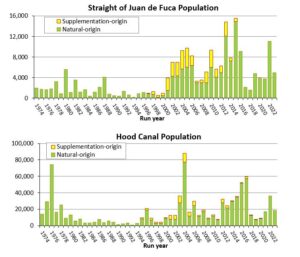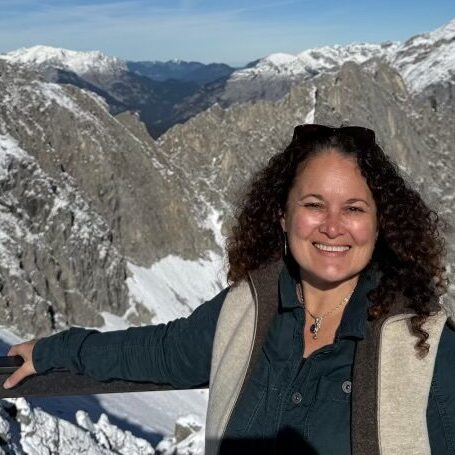Hood Canal salmon run sees booming recovery as fish face extinction
Seattle Times, Oct 3, 2024
HCCC convenes partners and experts to develop technical guidance, advance actionable science, and prioritize implementation actions to lead Hood Canal and Eastern Strait of Juan de Fuca (ESJF) summer chum salmon recovery toward our goal of healthy and harvestable populations, and removal from the Endangered Species List.
HCCC is the Regional Recovery Organization for
Environmental Species Act-listed
Hood Canal and ESJF summer chum salmon.
Hood Canal is home to all eight pacific salmon and trout species. Hood Canal summer chum salmon, Chinook salmon, steelhead, and bull trout are listed as threatened under the federal Endangered Species Act (ESA).
Hood Canal summer chum populations are approaching recovery goals, showing substantial improvements in abundance, productivity, geographical distribution, and genetic diversity
Quality habitat will ensure summer chum resilience
Managing fishing and improving habitat is helping salmon
Healthy and Harvestable Populations is the Goal
Recent analyses show a marked improvement in abundance, productivity, and spatial diversity. Summer chum salmon from Hood Canal and the Eastern Strait of Juan de Fuca (ESJF) may soon be removed from the Endangered Species List. Much work remains to get the populations over the finish line, and to ensure their protection into the future.
Summer chum were listed as threatened with extinction under the Endangered Species Act (ESA) in 1999.
Recovery success is largely due to the efforts from multiple partners that have continued since before the ESA listing, including the Tribes, State agencies, Federal agencies, Hood Canal and ESJF communities, Counties and local governments, and salmon recovery practitioners.
HCCC has led implementation of the Hood Canal and ESJF Summer Chum Recovery Plan, with data-based prioritization of the issues and actions most urgent for recovery.
The co-managers (Tribes and WA state (WDFW)) have been instrumental in providing input, feedback, and review to ensure there is a comprehensive understanding of the status and trajectory of summer chum salmon towards delisting, recovery, and sustainability.
The status of summer chum populations’ spatial structure, diversity, and resilience to climate impacts are currently being evaluated. The dedicated partners continue to work on these aspects inspired with the understanding that recovery is possible.
The Hood Canal Summer Chum Evolutionarily Significant Unit (ESU) is comprised of two populations: Hood Canal and the Strait of Juan de Fuca (SJDF). Both populations need to meet recovery criteria for the to be removed from the Endangered Species List.
HCCC updates and describes performance status and trends for the Hood Canal Summer chum evolutionarily significant unit (ESU) using the most recent information, including its populations and subpopulations. The current viability analysis indicates that both the Hood Canal and Strait of Juan de Fuca populations are currently performing at extinction risks of <5%. Incorporating only the past 23 brood years (beginning with brood year 1998), the extinction risks for both populations were estimated to be 0% with exploitation rates of 10% or less. This period covers the entirety of the record since the ESU was added to the Endangered Species List. These results also indicate that the extinction risks for both populations would be approximately 0% (or perhaps slightly higher) even with modestly higher exploitation rates on average under existing environmental conditions.
Summer Chum Abundance – Total Run Size

HCCC is working with its members and partners to analyze the status of threats to summer chum salmon and other potential factors that could be limiting further success.
Success of summer chum recovery to date can be attributed to multiple aspects: harvest management, habitat restoration and protection, land use, and improved understanding of summer chum salmon life history, biology, and the many factors that affect survival. Tremendous efforts in the estuaries and river systems of Hood Canal and the eastern Strait of Juan de Fuca have been major contributors to summer success. Very substantial habitat restoration work has occurred, which is continuing in many areas, to restore the estuaries and stream reaches of the Union River, Skokomish River, Dosewallips River, Duckabush River, Big and Little Quilcene Rivers, Salmon and Snow Creeks, Jimmycomelately Creek, Dungeness River, as well as other important streams in the region. All these efforts have significantly improved habitat conditions for summer chum and further improvements are expected.
HCCC is working with the Co-Managers (Tribes and WDFW) to assess the status of summer chum spatial diversity and what is needed to provide resilience and long-term sustainability in the face of forever changing environmental conditions.

HCCC provides technical information to the co-managers and NOAA Fisheries to aid in the analysis of harvest-related aspects of recovery; this information can be used to help facilitate discussions related to the development of harvest regimes consistent with summer chum recovery. To learn more see section 8 of the Guidance Document.
The Base Conservation Regime (BCR) was formulated in the 1990s to minimize incidental harvests of the summer chum populations during the recovery period. It was developed at a time when the populations were at critically low levels and strongly affected by the warm phase of the Pacific Decadal Oscilation (PDO). Co-managers recognized when developing the BCR that the harvest strategies employed would “continue to evolve and adapt as additional information is collected, analyzed, and incorporated”. Co-managers are currently evaluating harvest regimes developed in coordination with HCCC. HCCC has recommended that three harvest regimes be considered for use under different circumstances:
HCCC utilizes the Guidance for Prioritizing Salmonid Stocks, Issues and Actions to help guide high priority project development.
The prioritization framework determines a prioritized set of recovery/restoration actions for salmonid stocks produced in the geographic area that encompasses the Hood Canal summer chum ESU (the Hood Canal Basin, as well as portions of Admiralty Inlet and the Eastern Strait of Juan de Fuca), including the spawning areas for the summer chum ESU as well as for the Skokomish and Mid-Hood Canal Chinook populations, which are also listed as threatened under the ESA designation.

Species are placed on the Endangered Species Act (ESA) list as either threatened or endangered of extinction. We have been working since the summer chum salmon listing in 1999 to recover the populations and get them off the ESA list. The summer chum salmon story is remarkable and unique among Pacific salmon species. All indications suggest that summer chum are recovered, and can be de-listed, which, to date, no ESA-listed salmon species has achieved.
Recovery is forever: De-listing is a vital step toward recovery
Preparing the de-listing petition will allow necessary discussions to ensure that de-listing is done correctly. Initiating the process for de-listing will facilitate discussions to understand any outstanding issues toward recovery. Looking at summer chum recovery through this lens provides the chance to define what post-delisting looks like for a Pacific salmon population. HCCC is developing the following plans to prepare a petition to remove Hood Canal summer chum salmon from the Endangered Species List:

